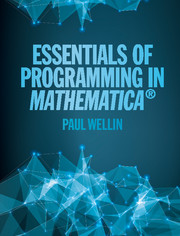2 - The Mathematica language
Published online by Cambridge University Press: 05 December 2015
Summary
Throughout our history, humans have developed thousands of languages in order to communicate with each other. These natural languages, such as Mandarin, Bantu, or Finnish, evolved through ordinary usage over millennia, with rules for grammar developing organically and changing frequently. Then in 1879, Gottlieb Frege, in his Begriffsschrift, invented what is often referred to as the first formal language. Formal languages are designed for specific tasks; in Frege's case, he was attempting to formalize mathematical logic. Mathematics itself is a formal language, one used to express ideas about number, pattern, space, and other concepts. Although they too have evolved over many years, mathematics and logic differ from natural languages in that they have been formally constructed and have quite explicit and rigid rules regarding syntax.
Programming languages are, like mathematics, formal languages, but they are constructed to communicate with a machine and to command it to carry out certain instructions. Thought to have their origin in the 1940s and 1950s when the first digital computers came about, in fact programming languages go back much earlier to the creation of the Jacquard loom (1801), player pianos (mid-1800s), and mechanical organs (Anselmo Gavioli, 1892), all of which used physical punch cards or rolls to code and store instructions to weave fabric or play an instrument. The connection with computing probably begins with Herman Hollerith's innovation of using punch cards to store information for the US Census of 1890. Hollerith later founded a company to market his inventions and in 1924, that company became IBM.
Regardless of the mechanism used to store programs, all programming languages are described by specifying their syntax and semantics. Syntax refers to the form, indicating what symbols can be put together and in what order to make a meaningful construct in a given language. In other words, the syntax of a programming language is the set of rules that define what is a valid input or program.
- Type
- Chapter
- Information
- Essentials of Programming in Mathematica® , pp. 19 - 58Publisher: Cambridge University PressPrint publication year: 2015

